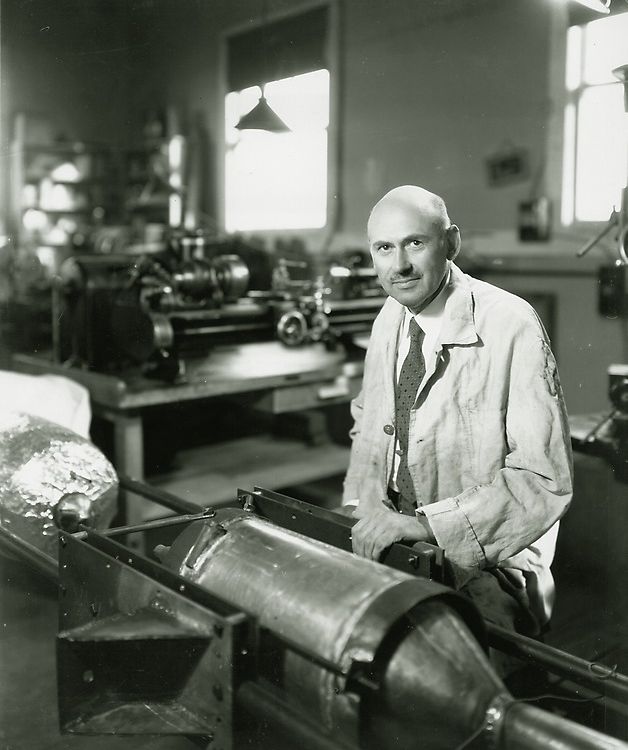Robert Goddard Was All Business in Launching His Rocket Career
The inventor’s handmade tools are now museum artifacts.

When you hear the name Robert H. Goddard—an American physicist and engineer—what probably comes to mind are his experiments with rockets. Perhaps you’ve seen the grainy but prophetic monochrome films of Goddard and his small staff preparing to launch rockets in the New Mexico desert. Like any inventor, Goddard’s successes were mixed with the occasional failure: After one rocket launch went wrong, Goddard and his team found themselves stamping out a brush fire in a Massachusetts field.
Many of Goddard’s early rockets are today part of the National Air and Space Museum’s permanent collection, some of which are on display at the Museum in Washington, D.C., and at the Steven F. Udvar-Hazy Center in Chantilly, Virginia. While these rockets might be the most iconic Goddard objects we have, the Museum in fact has a broader collection of his artifacts, which illuminate a larger story. Early experimenters such as Goddard and his team did not just engineer rockets—they first needed to work through numerous challenges in how to test, fuel, and launch the new technology.
One artifact currently on display at the Udvar-Hazy Center is an example of the foundational framework Goddard first had to lay before becoming a successful rocketeer. The object dates from 1923 or 1924, shortly after Goddard began his liquid-fuel experiments in 1921. Switching from solid propellants to liquid ones presented Goddard with a pressing set of challenges, including how to transport liquid propellants, which, unlike solid propellants, need to be added just before launch. Complicating matters, Goddard’s chosen oxidizer (which enabled the combustion of the fuel) was liquid oxygen (LOX), which must be chilled to a temperature close to –300°F.
Museum visitors can see firsthand the solution Goddard devised. He first poured the liquid oxygen into a vacuum flask (commonly known today by its generic trademark, thermos). Goddard’s flask, which could hold about 32 ounces of liquid oxygen, helped insulate the propellant. Goddard then added additional insulation, wrapping the flask in layers of wool and felt. To transport the frozen bundle out to the launch site (and protect his hands from the dangerous cold), he placed the flask on a wood tray, which he lifted by a few lengths of twine and rope tied to each end.
/https://tf-cmsv2-smithsonianmag-media.s3.amazonaws.com/filer_public/d6/98/d69861a5-b85f-46ac-ab9d-a0c828380fe4/felt-covered_flasks.jpg)
/https://tf-cmsv2-smithsonianmag-media.s3.amazonaws.com/filer_public/6e/3b/6e3b88a9-054c-43ca-a388-1119cd9e08bc/goddards_assistants.jpg)
Smithsonian/National Air and Space Museum (NASM 2006-6059)
/https://tf-cmsv2-smithsonianmag-media.s3.amazonaws.com/filer_public/37/fb/37fbf188-851a-490c-86ab-1a88a965e038/09e_sp25_colleenanderson_portrait_nasm2025-00298.jpg)
Finally, just as Goddard’s LOX container reminds us that early rocketeers were solving complex problems, I hope our visitors also see the container as evidence that trailblazing work—across many fields of research—is so rarely the product of just a single famous figure. Esther Goddard, wife of the rocketeer, donated the LOX flask along with more than 60 other objects to the Smithsonian in the 1950s. It was Esther who worked in the postwar period to establish Goddard’s legacy—through artifact donations, the organization of his papers, and the filing of posthumous patents. That is to say nothing of the work she did during her husband’s lifetime: photographing launches, deciphering his notes, and extinguishing field fires. The LOX flask stands as testament to the fact that technological innovations and their awareness by those outside the engineering community—including those by the notoriously private Goddard—are the work of more than one individual.
Colleen Anderson is a curator in the National Air and Space Museum’s department of space history.
This article is from the Spring 2025 issue of Air & Space Quarterly, the National Air and Space Museum's signature magazine that explores topics in aviation and space, from the earliest moments of flight to today. Explore the full issue.
Want to receive ad-free hard-copies of Air & Space Quarterly? Join the Museum's National Air and Space Society to subscribe.
